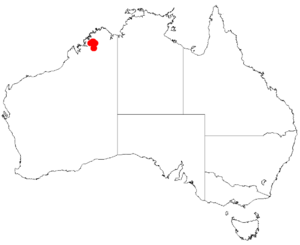Acacia kimberleyensis facts for kids
Quick facts for kids Acacia kimberleyensis |
|
|---|---|
| Conservation status | |
| Scientific classification | |
| Genus: |
Acacia
|
| Species: |
kimberleyensis
|
 |
|
| Occurrence data from AVH | |
Acacia kimberleyensis is a special type of shrub found only in certain parts of north-western Australia. This means it is endemic to that area, growing naturally nowhere else in the world. It belongs to the large plant group called Acacia.
What Does It Look Like?
This upright shrub usually grows to about 1.5 meters (5 feet) tall. Its branches are thin and feel a bit sticky, especially when they are young. They also have tiny ribs and look shiny from a natural resin.
Leaves and Flowers
The leaves of Acacia kimberleyensis are called phyllodes. They are flat, green, and very narrow, like tiny lines. Each leaf can be between 8 to 16 centimeters long and less than 2 millimeters wide.
This plant shows off its bright yellow flowers from June to July. The flowers grow in simple spikes, usually in pairs where the leaves meet the stem. These flower spikes are quite small, only about 2 to 3 centimeters long.
Seeds and Pods
After the flowers bloom, long, narrow seed pods form. These pods are about 7 to 10 centimeters long and only 2 millimeters wide. They are thin and have small lines running along them. The edges of the pods are slightly winged. Inside, you'll find shiny greenish-black seeds. Each seed is shaped like a narrow rectangle and is about 6 millimeters long.
Where Does It Grow?
Acacia kimberleyensis is found in a small part of the Kimberley region in Western Australia. It doesn't grow everywhere in this area. Instead, it's found in two separate spots. One spot is in the Packhorse Range. The other is near Mount Agnes, which is about 80 kilometers (50 miles) north of the Packhorse Range.
This shrub likes to grow among rocky areas and on flat plains. It prefers to grow in sandstone rocks that have shiny quartzite veins. You'll often find it as part of a Eucalyptus miniata woodland, which is a type of forest, growing alongside spinifex grasses.


